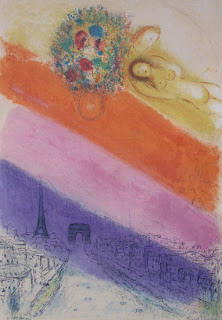PABLO PICASSO 1881-1973
Figures / Personnages, circa 1899
Original Hand Signed Charcoal and Colour Crayon Drawing on paper.
21 x 13 cm / 8.3 x 5.1 in
Gilden's Arts Gallery is proud to show this original drawing, hand signed in blue crayon "Picasso" in the lower left of the image.The work is accompanied by a certificate by from Monsieur Claude Ruiz-Picasso dated, le 3 octobre 2011.
The authenticity of this work has kindly been confirmed by Madame Maya Widmaier-Picasso.
The precise date and location in which this artwork was executed in not known, but the year 1901 was certainly a turning point in Picasso's career and development as an artist.
For the first five months of the year, Picasso lived in Madrid, before moving to Paris to hold an exhibition of sixty four of his works at Ambroise Vollard's Gallery in June 1901. At the age of just nineteen, the show was a huge success for the young artist, but Picasso's money from the proceeds soon ran out, as did his buoyant mood. He descended into a depression which was deepened by the suicide of his close friend Carles Casagemas, whose love interest Picasso had been courting.
He abandoned the bright colours which had dominated the works he had exhibited at Galerie Vollard and turned to a sombre, monochrome palette, often dominated by blue tones. This was to mark the start of his famous Blue Period, during which Picasso would depict the Parisian underclass of gaunt prostitutes, beggars and prisoners. Executed on the precipice of this change in style, the present work however, shows the average person on the street, well dressed and respectable. It is executed though in a reduced palette of browns and blues, and the figures are formed with bold, deft strokes. Picasso captures a sense of movement in the diagonal thrust of his lines, catching the men, women and children as they move about their daily business.
This drawing is very similar in style and techniques to the ones realised by Pablo Picasso from 1900 until 1901. It is known that 11 sketchbooks were realised by Picasso in Barcelona, Paris and Madrid. These sketchbooks are very homogene in style and always represent the same motifs: coffee and street scenes (like in ours), brothels and public places.
The sketchbooks would allow the artist to make notes of ideas, drawings and scenes for his later paintings.

